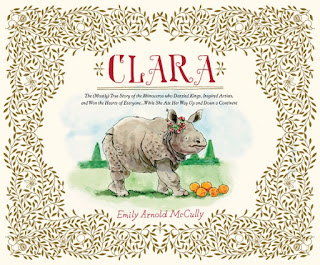Emily Arnold McCully is the author of the new children's book Clara, which focuses on a famous 18th century rhinoceros. Her many other books include Mirette on the High Wire and Marvelous Mattie. She lives in New York City and Columbia County, N.Y.
Q: How did you learn about Clara the rhinoceros, and was
there anything that particularly surprised you about her story?
A: I learned about Clara when browsing the stacks of my local
university library (a wonderful boon to have access to it--browsing yields
wonderful discoveries not usually available when simply searching for titles on
a computer).
The book, by Glynnis Ridley, a scholar, is a detailed
examination of every aspect of Clara's journey. I saw a children's book
embedded in its detail.
I was as innocent of information about the rhinoceros as
those 18th century Europeans, so much surprised me. I was very impressed by the
endurance of both Clara and the Captain, and by the effect she had on
onlookers.
I had seen Longhi's paintings in Venice and always found
them wonderfully evocative. They aren't really very accurate portraits, but
they do convey the mystery and comic qualities of her appearances.
Q: How do you research your books, and is there a time
period you've especially enjoyed looking into?
A: I prefer to research my stories with actual books, but
increasingly, I have to use the internet (very carefully!) There are primary
sources available, for instance, a broadside of an appearance by Clara in
London.
I am most at home in the 18th and 19th centuries, but have
researched medieval China (Beautiful Warrior) and closed off Japan (Manjiro). My
mission is often to recover forgotten or little known girls and women who made
significant contributions to the human story.
Q: You've written for a variety of age groups. Do you have a
preference?
A: After having produced picture books for decades, I have
lately written much longer books. Ida M. Tarbell is YA and I enjoyed writing it
immensely, mostly because of the subject, also because I could pretty much
include all that I wanted to--there was no restriction on length or complexity.
That's true also of a current biography of Ada Byron
Lovelace, known as the first computer programmer.
That said, I'm at the moment illustrating a picture book
about Caroline and William Herschel, sister and brother astronomers of the late
18th and early 19th centuries. In their case, the illustrations really do inform
the story. A longer book would certainly be interesting, but not as effective,
I think.
Q: Who are some of your favorite authors?
A: I read history and fiction mostly and have some
favorites, but hate to single them out. I will say that no author has moved me
more than Elena Ferrante, for her devastating depiction of the experiences of
girls and women in my lifetime (even though set in Naples).
I admire many children's authors -and, sorry, don't want to
be pinned down there, either!
Q: Can you say more about what you’re working on now?
A: I'm working on the Herschels, called Caroline's Comets,
on the Ada book and on a fictionalized early life of Sacagawea's son, whose
name was Jean Baptiste Charbonneau. Also a picture book about the design and
construction and history of the Lincoln Memorial.
--Interview with Deborah Kalb




No comments:
Post a Comment